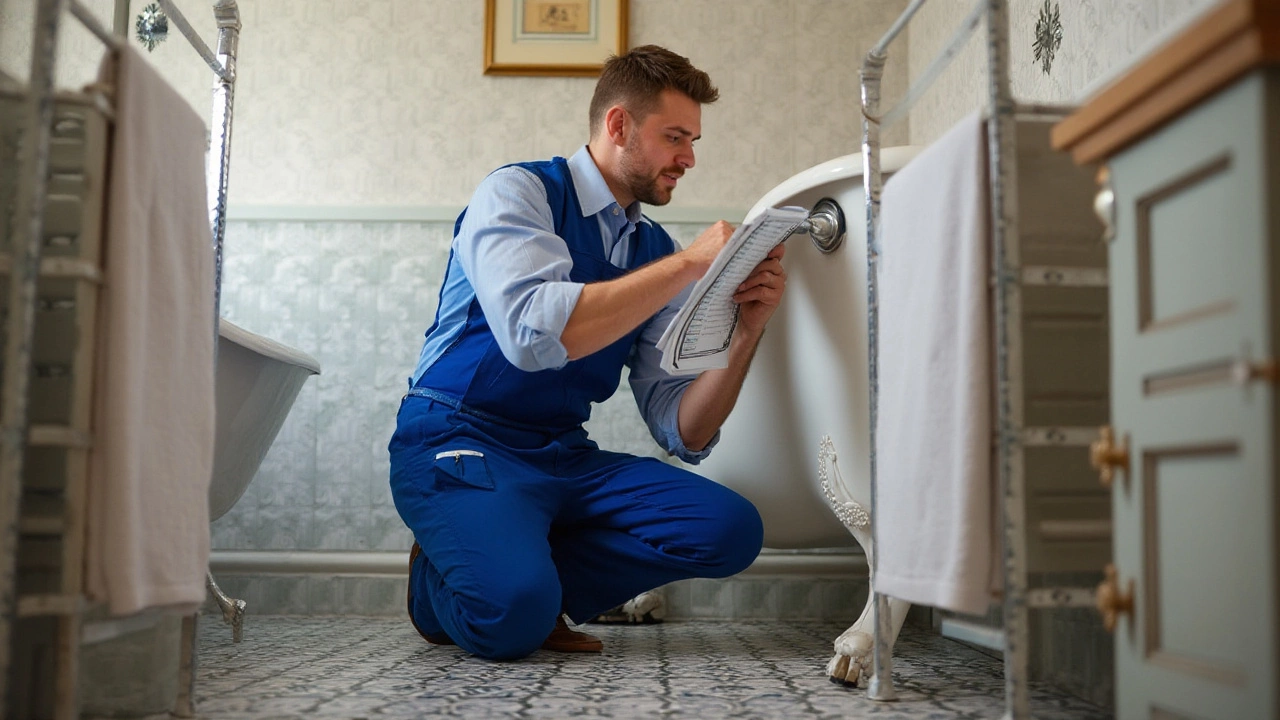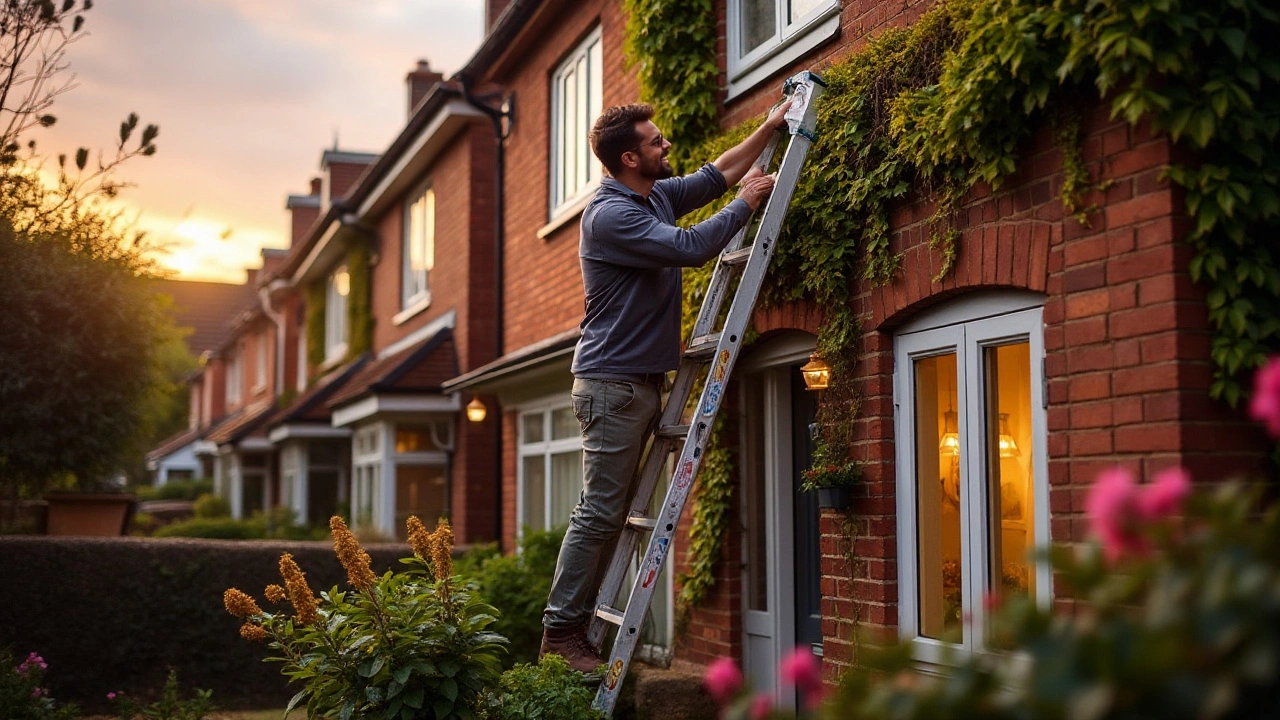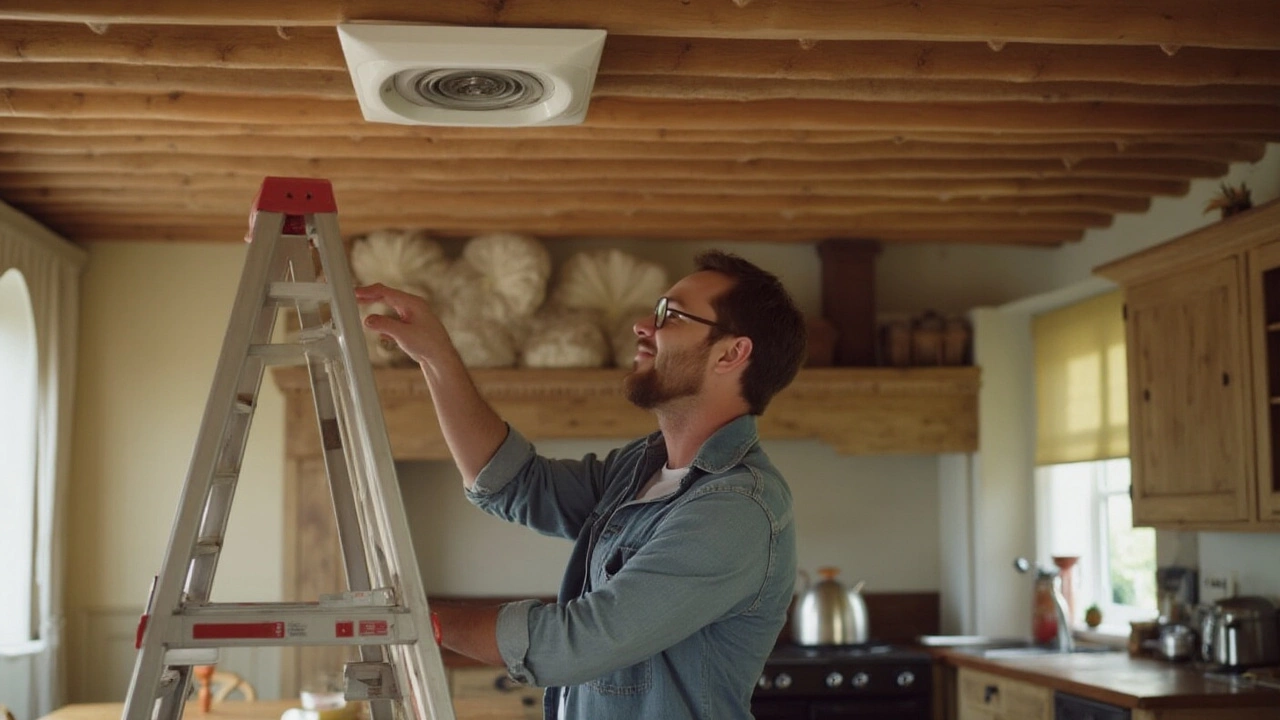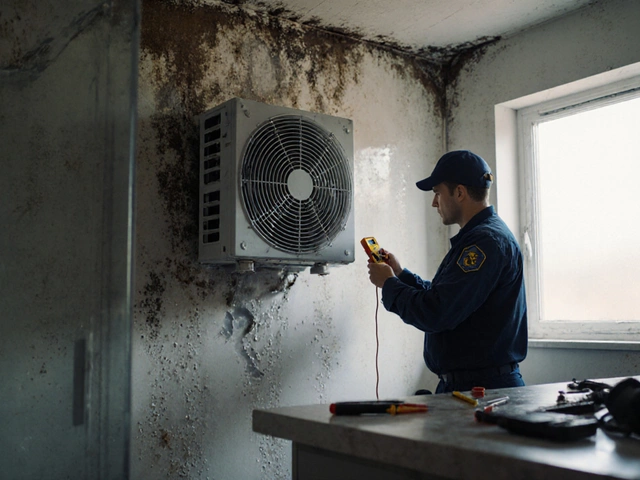Extractor fans play a crucial role in keeping the air fresh and pleasant in parts of our homes where humidity and odors tend to build up, like bathrooms and kitchens. While they might seem simple, their installation involves a degree of know-how that bridges both plumbing and electrical expertise.
It's not uncommon for homeowners to wonder if a plumber can help install an extractor fan. Given that these devices are designed to control moisture and airflow, there are situations where a plumber's skills, particularly those related to handling ducts or adjusting routine plumbing layouts, become incredibly valuable. Let's dive into the nuts and bolts of why you might want to consider a plumber for this task.
- Understanding the Role of a Plumber
- Plumbers vs. Electricians: Who to Call?
- When Plumbers Are the Right Choice
- Installation Tips and Tricks
- Maintenance for Longevity
Understanding the Role of a Plumber
Plumbers are often the unseen heroes of our household’s infrastructure, taking care of everything from leaky faucets to complex pipework systems. But their role extends beyond just handling water systems. True craftsmen, they possess a detailed understanding of how various household systems integrate. When it comes to fitting an extractor fan, some people are surprised to learn that a plumber might be the right person for the job. The mystery surrounding their capabilities often involves misunderstandings about their skill sets.
A plumber's primary responsibility is installing and repairing piping systems, but this includes much more than just water pipes. They frequently manage ventilation systems, which are crucial for maintaining proper air quality and reducing moisture levels. Kitchen exhausts and bathroom fans are no strangers to their expertise. Plumbers are instrumental when ductwork needs adjustment to ensure proper ventilation, especially in areas where moisture needs to be consistently expelled.
These skilled professionals often work closely with electricians, particularly when plumbing and electrical systems intersect. Their hands-on experience with the structural aspects of buildings means they understand how to maneuver through wall spaces, ceiling voids, and floor cavities to install ventilation systems without compromising the existing infrastructure. As Mike Holmes, a famous contractor, once said,
"It's not just about making things fit, it's about understanding why they fit that way."
One of the lesser-known facts is that in some cases, when an extractor fan involves plumbing to manage moisture levels effectively, it might be a task best suited for a plumber rather than an electrician. They have the right tools and skills to appropriately seal areas to prevent leaks, which is crucial in damp environments. In these scenarios, hiring a plumber can ensure the system not only works effectively but also stays trouble-free in the long run.
Extractor fan installation involves more than just mounting and plugging it in. There's a strategic aspect that involves ensuring the fan correctly pulls air out of the room, which plumbers are familiar with due to their work with natural airflow in plumbing systems. Though their domain traditionally oscillates around water, they bring a valuable perspective to ensuring mechanical ventilation meshes well with the space's architecture. It’s an interesting dynamic between different trades, each bringing unique skill sets to achieve the common goal of a healthier living environment.
When considering the statistical impact, homes using a combination of electrical and plumbing expertise for ventilation report fewer issues post-installation. A survey conducted by Building Systems Magazine in 2022 revealed that homes integrating plumbers into their repair and installation processes saw a 15% decrease in follow-up maintenance needs within the first three years, a compelling argument for including them in such projects. This illustrates that a collaborative approach often yields the most sustainable results.
Plumbers vs. Electricians: Who to Call?
When faced with the task of installing an extractor fan, homeowners often find themselves at a crossroads—should they call a plumber or an electrician? While both professionals bring critical expertise to the table, understanding the nuances of their roles can help in making a more informed decision. At first glance, one might lean towards hiring an electrician, given the electrical connections required for an extractor fan. Electrical safety is paramount, and an electrician is adept at ensuring that the wiring and power supply functions without any hitches.
Nevertheless, a plumber should not be overlooked, especially in situations where the installation involves complex ventilation systems intertwined with water supply lines. Plumbers are not only skilled in manipulating ductwork to accommodate fan installations but also knowledgeable in ensuring that the plumbing system and airflow remain harmonious. For instance, in a scenario where duct paths overlap with existing pipes, a plumber can navigate the intricate web of existing installations without disrupting the essential facets of your home’s plumbing.
Sometimes, the decision boils down to the specific needs of the installation. If the task involves more significant changes to the structure of the existing ventilation system, such as adding additional ductwork or modifying plumbing fixtures, a plumber could be the best choice. On the other hand, the necessity for understanding electrical circuits and compliance with electric codes drives the need for an electrician.
It's worth noting that in many cases, both tradespeople might need to collaborate to tackle particularly complex installations. As stated by a renowned home improvement expert, "Synergy between trades can lead to more efficient and robust solutions when installing systems like extractor fans."
"The integration of electric and plumbing expertise often ensures a safer and more efficient completion of home projects," – Jane Smith, Home Improvement Specialist.To conclude, evaluating the specific requirements of your project can help you decide whether to dial up a plumber or an electrician. Each professional possesses specialized skills that can be beneficial depending on the intricacies of the job at hand.

When Plumbers Are the Right Choice
Choosing the right professional for your home improvements can be a bit of a puzzle sometimes. While electricians are the go-to experts for anything involving wires and circuits, there are moments when plumbers, with their unique expertise, fit the bill perfectly. In the case of installing an extractor fan, it's crucial to understand how a plumber’s skills align with your specific needs.
Primarily, plumbers are trained to handle challenging aspects related to air and water flow. Their knowledge of evolving ventilation standards means they can place an extractor fan in spots where moisture control is critical. For instance, during the installation of a new bathroom or kitchen, the space layout might require restructuring water and air ducts. In these scenarios, a plumber's ability to integrate the extractor fan with existing ductwork is unparalleled. Moreover, they come in handy when systems need to be connected properly without the risk of future leaks or duct blockages, maintaining efficiency and safety throughout.
Interestingly, plumbers often address the complex nature of duct installation and venting, an area where they overlap with electricians. The journey begins with analyzing the feasibility of adding an extractor fan to an existing structure, rather than starting from scratch. This means checking the existing setup, finding the best exit point for the fan's exhaust, and ensuring that all parts fit neatly without hindering functionality. Plumbers use their skills to tackle these installation challenges straight on, as duct placement doesn't always involve electrical adjustments but instead requires intricate knowledge of airflow dynamics and pressure balancing.
According to Todd Grossman from 'Home Ventilation Today', “A capable plumber is well-versed in navigating the twists and turns of a housing system's built-in pathway, understanding how to map out airflows effectively.” This insight is essential when deciding which professional can do the best job for your needs. Often, the subtle testimonies from satisfied homeowners suggest that plumbers provide the precise adjustments necessary to ensure the system operates with maximal efficiency while avoiding undue pressure on the fan itself.
Suppose your plan involves installations in areas not quite close to mains power sources. In that case, a plumber might be better placed to reroute pipes and vents enduringly, rather than relying solely on wiring adjustments. Their expertise in modifying the infrastructure also means they can recommend and implement durable materials that work best under humid conditions, something crucial for reducing potential damage and increasing lifespan. Therefore, the choice isn't just about who can handle electrical connections—it’s about using the dental precision with which a plumber handles everything from ventilation systems to remodels to leave a lasting impact, optimizing airways without breaking a sweat.
Here’s a quick list capturing instances where a plumber might be your better choice for installing an extractor fan:
- When the primary concern is moisture control in spaces with intricate plumbing setups.
- If vent ductwork requires significant modification or rerouting.
- When addressing issues related to existing blockages within ventilation pathways.
- For implementing solutions involving both air passageways and plumbing lines.
- If the installation involves environments with high humidity levels.
Installation Tips and Tricks
Installing an extractor fan might appear to be a straightforward task, but ensuring it's done effectively requires attention to detail and understanding of the involved steps. To begin with, assessing the space where the extractor fan will be installed is crucial. Determine the appropriate size of the fan, as it's essential to have a fan that can adequately handle the ventilation needs of your bathroom or kitchen. A fan that's too small might not effectively clear moisture, while an oversized fan can lead to unnecessary power consumption.
For placement, keep in mind that the effectiveness of your extractor fan relies heavily on where it's positioned. Ideally, bathroom fans should be placed on the ceiling, close to or directly above the shower or bathtub area to efficiently remove steam. In kitchens, installing the fan near cooktops or stoves is vital to combat cooking odors and smoke. An interesting stat from a building code report suggests that fans must be ducted to the exterior to mitigate backdrafts and enhance air quality. Ensure that the fan's duct runs as short and as straight as possible, minimizing bends to improve airflow.
Once you've sorted out the placement and proper sizing of your extractor fan, consider the actual installation process. Disconnect any power supply to prevent accidents, a crucial safety step often overlooked in DIY installations. You'd want to cut a hole where the fan will sit, big enough to fit the fan snugly but not too large to avoid creating unnecessary gaps. Carefully follow the manufacturer's instructions for securing the fan mount, as these can vary widely between models. Opting for screws that don't rust is a good measure to prolong the fan's lifespan since these will withstand the moisture-heavy environments commonly experienced in bathrooms and kitchens.
Now, we shouldn't overlook integrating best practices from the dual expertise of electricians and plumbers. If you're handling this alone, make sure to align your fan's wiring correctly with your home’s power supply. While this may sound simple, missing by even one connection can render the fan useless until properly fixed. The notable electrician John Watson once said, "Precision in wiring isn't just about safety; it's the linchpin for efficiency." Also, check for any leaks in ducts that might undo your valuable work. Using duct tape or, better yet, metal clamps to secure duct connections will help keep the system airtight.
Another aspect to factor in is the noise level of the fan. Although it may not be the top priority for everyone, a fan with a lower sone rating can significantly enhance your space's comfort level, especially for fans installed in areas used frequently. So, balancing power with quiet operation is a real win-win when choosing a model. Many experts suggest that fans rated below 3 sones provide a good balance between performance and sound.
When connecting the ductwork, opting for the correct type of duct is also essential. Rigid ductwork is usually preferred for its durability and efficiency, although flexible ducts might work where space constraints are a factor. If using flexible ducts, be sure not to stretch them too thin and keep curves to a minimum to retain efficient airflow. Consider insulating ducts that run through cooler parts of the house to prevent condensation buildup, which can lead to mold.
And let's not forget about some effective finishing touches. Sealing around the fan with appropriate caulking ensures no air leaks through holes bigger than needed around the mounted fan. Once you've installed the fan, test it by checking for adequate suction and ensuring there’s no vibration which often indicates improper securement or an unbalanced fan. Regularly check vents for any blockages or signs of wear, as consistent function checks can extend the life of your installation.

Maintenance for Longevity
Extractor fans, like any other household appliance, require proper upkeep to ensure they function optimally for a long time. Regular maintenance not only prevents untimely breakdowns but also enhances the efficiency of your extractor fan. To begin with, consistent cleaning of the fan blades and housing is crucial. Dust and grease tend to accumulate over time, especially in kitchen environments. A simple wipe with a damp cloth and a mild detergent can help remove grease buildup. Doing so every couple of months will keep your extractor fan in good condition.
Periodic checks to ensure that the fan's venting system isn't blocked are also essential. An obstructed vent can reduce efficiency, cause overheating, and eventually lead to motor failure. To avoid this, examine both the internal and external vent openings. Ensure that there are no obstructions by leaves or debris on the outside. It's a simple task but can make a huge difference in the longevity of your fan. Furthermore, if your fan has a removable filter, it's wise to clean or replace it every few months depending on the manufacturer's guidelines. Often overlooked, filters play a pivotal role in maintaining air quality.
"Maintenance is not limited to visual checks; listening is equally important. If your fan starts making unusual noises, that could be a sign something isn't quite right," says John Mitchell, a home improvement expert. "It's better to address these abnormalities early before they become major issues."
Additionally, electrical components of the fan require attention. Ensure the power switch and wiring are intact and free of damage or wear signs. Engaging a professional for a yearly electrical inspection can prevent potential hazards related to faulty wiring. Beyond individual component care, ensuring that the installation area is well-ventilated can increase the efficiency of the fan. Poor airflow can lead to restricted performance, further stressing the fan's motor. Regularly ensuring there’s no clutter near the fan can significantly help maintain its efficiency.
For technical enthusiasts or those comfortable around basic tools, inspecting and tightening the fan blades is advisable. Over time, with constant operation, screws and fasteners may loosen, leading to vibrational noise or reduced performance. A periodic manual check can resolve this issue effectively. Additionally, consulting the user manual for specific maintenance instructions tailored to your model is wise. Often these manuals contain preventative care tips that can save time and money in the long run.
Finally, record keeping is an integral aspect of maintaining any appliance. Maintain a log of when cleaning, inspections, and filter changes were last done. This practice can prevent overlapping efforts or neglected maintenance periods. With some attention and a commitment to a maintenance schedule, your plumber-installed extractor fan can serve your household well for years without the need for premature replacements or extensive repairs.




